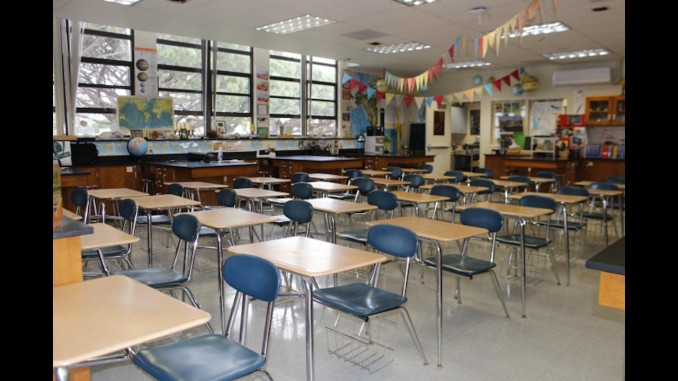
As the Covid-19 pandemic tore across the globe in March 2020, schools across the country shut down. The goal was simple: to slow the spread of a virus that has now claimed over half a million lives in the U.S. alone.
And although the end of January marked the close of the deadliest month yet of the pandemic, the push to re-open schools has now reached a fever pitch. According to the CDC’s own guidelines, more than 90% of U.S. students live in areas with high rates of community spread. That hasn’t stopped President Biden and the CDC from leading the charge for re-opening, with the CDC even claiming that “vaccination of teachers is not a prerequisite for safe reopening of schools.”
And the rush to re-open has yielded results: from New York to Chicago to San Francisco, teachers’ unions have settled a variety of agreements to return to in-person instruction.
There is no doubt that distance learning has been a disaster for most working-class families. It has added yet another burden to the immense pressures working people face, as millions have lost their jobs, seen their hours or wages cut, and faced hunger, eviction, and despair.
Some researchers have suggested that as many as 42 million Americans do not have access to reliable internet access. For families that continue to go in for work, the scramble to organize childcare has been a major challenge. Students’ academic and social development has suffered, and the longstanding class and racial inequities of society have been exacerbated. The isolation that students face due to not being able to connect with other young people has had negative consequences on students’ mental health.
In other words, it is absolutely true that the experience of “distance learning” has been a disaster for poor and working-class students, but that’s a systemic failure, not one caused by teachers. Public education has been severely underfunded for decades, and the investment in distance learning has been completely inadequate.
In response to this crisis, many politicians and members of the media have found a new religion: the gospel of equity. In a recent New York Times article, David Brooks argued that “this situation is especially devastating to poorer Black and Brown students.” Apparently Brooks didn’t do much listening to families of color before he wrote his editorial. The ongoing pandemic of racism, coupled with the fact that frontline workers have borne the brunt of COVID-19 infections, mean that the Black and Brown families that Brooks refers to have suffered the most: the death rate for Black, Latinx, and Indigenous people is at least twice as high as that of white patients. Not surprisingly, as the writer and activist Keeanga-Yamahtta Taylor pointed out, “only eighteen per cent of Black parents and twenty-two per cent of Latinx parents would prefer to send their children back to in-person schooling full time, compared with forty-five per cent of white parents. Over fifty percent of Black and Latinx parents prefer to keep their children in remote learning.” Teachers aren’t fighting just to protect themselves, they’re fighting to prevent the spread of the coronavirus and the further devastation of communities that have been ravaged by this disease.
Of course, the real concern for the re-opening advocates isn’t equity. Where was this overwhelming concern just a year ago, when more than 50 million students were attending school in person? In cities from Detroit to Washington D.C, their water was poisoned by lead. In Oakland and Baltimore, their schools ran out of toilet paper and soap on a regular basis. In Los Angeles, they had up 39 students crammed into a classroom. In Texas, their hallways were patrolled by armed police officers, who charged children for crimes ranging from swearing to wearing inappropriate clothing. In New York, they were scanned by metal detectors and stopped and frisked by cops. In countless cities across the country, they entered classrooms completely lacking in modern air filtration systems. And more than 12 million students were “food insecure,” a fancy way of saying that they arrived to school with empty stomachs.
But that’s precisely the point: the real concern isn’t providing an outstanding education for all students. The real concern is getting students back to school so that their parents can be forced back to work, COVID-19 deaths be damned.
If the advocates of re-opening really cared about the communities most impacted by COVID-19 and distance learning, they wouldn’t insist that we return to schools with inadequate ventilation, overcrowded classrooms, and understaffed custodial services. They’d insist on a massive infusion of funding from the federal government to provide internet access for all students, smaller class sizes, more custodial staff, modern ventilation systems, and lead-free water.
It’s no surprise that the most ardent advocates of re-opening instead demand that we re-open an underfunded, crumbling school system. After all, education in every society serves to maintain the existing order and to socialize young people to function within it. In today’s world, that means educating children to function in the capitalist system, a system that’s based on the exploitation of the overwhelming majority of people on this planet. It’s a system rooted in racism, genocide, unceasing war and climate catastrophe.
Schools in this society were never meant to offer a real education to most of us. They were meant to train the children of the middle and upper classes to administer the system, and to train the rest of us to be obedient workers who know how to sit down, shut up, and follow orders.
We should refuse to accept the false choices that we’ve been offered. The question isn’t whether or not we should re-open schools exactly as they are, the real question is whether we should continue to accept a system that dehumanizes and warehouses young people to prepare them for a lifetime of servitude to the one percent.




